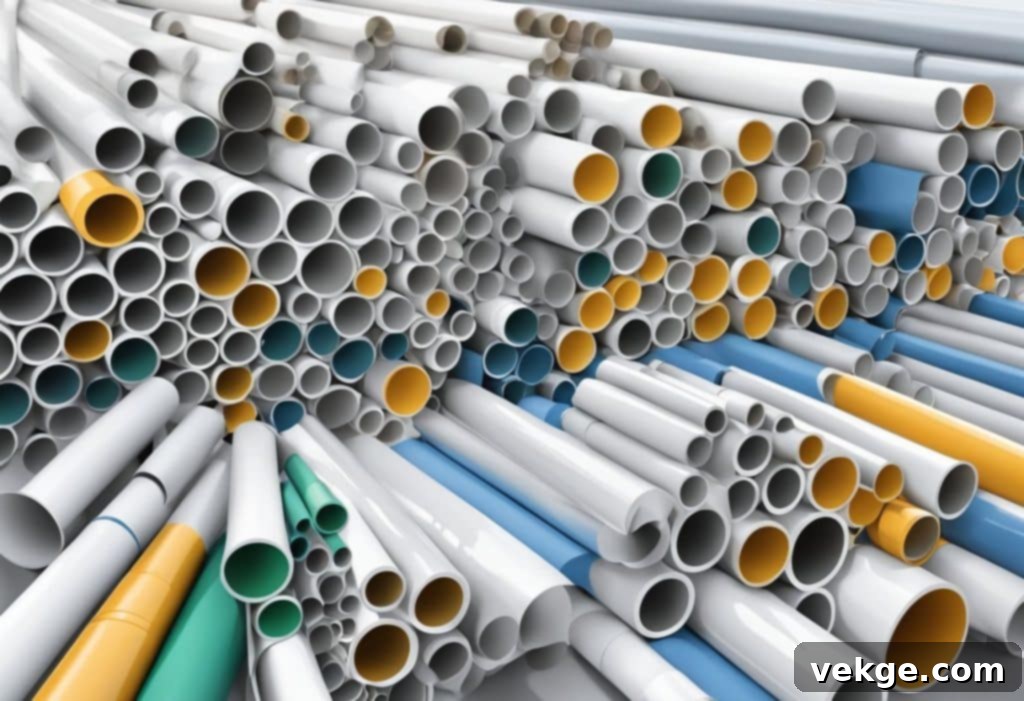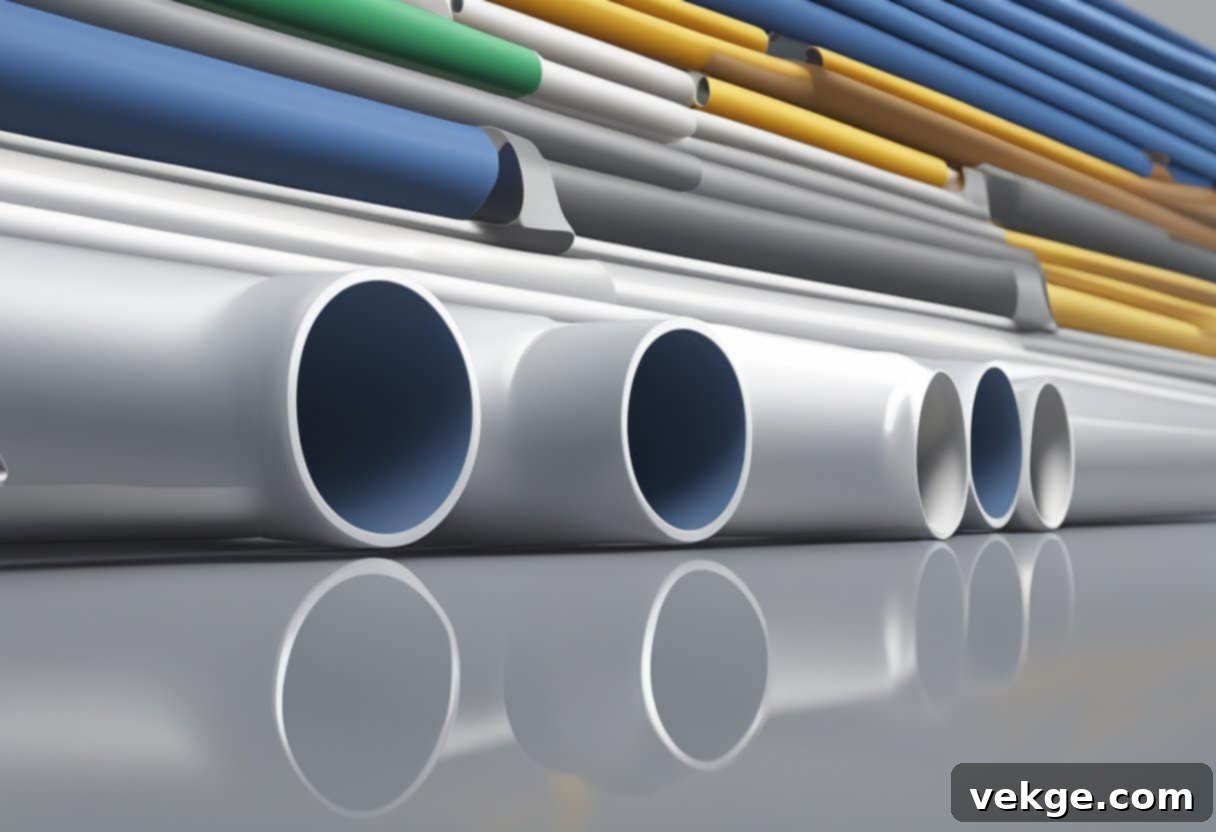PVC Pipes vs. Traditional Materials: A Definitive Guide to Choosing the Best for Your Project
Choosing the right material for water and sewer systems is a critical decision that impacts the longevity, performance, and overall cost of any construction project. While many options exist, PVC (Polyvinyl Chloride) pipes have emerged as a frontrunner due to their unique combination of properties. But how do they truly stack up against other established pipe materials like copper, PEX, steel, or cast iron? This comprehensive analysis delves into the characteristics of PVC and its counterparts, providing essential insights to help engineers, contractors, and homeowners determine the optimal piping solution for their specific needs.
Key Advantages of PVC Pipes
PVC pipes are a perennially popular choice for various applications, particularly in water and sewer infrastructure. Their widespread adoption is attributed to several core benefits that make them a reliable and economically sound investment.
- Lightweight and Easy to Handle: PVC’s lower density simplifies transportation, installation, and labor requirements, significantly reducing project timelines and costs.
- Exceptional Durability: Engineered for resilience, PVC pipes are built to withstand the rigors of underground installation and continuous use, offering a long service life.
- Outstanding Corrosion Resistance: Unlike metallic pipes, PVC does not rust, pit, or corrode when exposed to water, chemicals, or aggressive soil conditions, ensuring consistent flow rates and water quality.
- Cost-Effectiveness: From manufacturing to installation and maintenance, PVC pipes typically present a more economical solution compared to many traditional pipe materials.
- Versatile Applications: Their robust properties make them suitable for a diverse range of uses, from residential plumbing to large-scale municipal water and sewer networks.
Unpacking the Properties of PVC Pipes

The inherent characteristics of PVC plastic are what truly set it apart as a preferred material for piping systems. Understanding these properties provides insight into why it excels in so many different environments.
Exceptional Chemical Resistance
One of PVC’s most significant advantages is its impressive resistance to a broad spectrum of chemicals. This material remains unaffected by most acids, alkalis, salts, and various industrial fluids, making it an ideal choice for diverse applications. From municipal water treatment plants, where pipes encounter a range of disinfection chemicals, to chemical processing facilities and agricultural irrigation systems, PVC maintains its structural integrity and prevents contamination. Furthermore, PVC pipes exhibit excellent resistance to oxidation and UV radiation when properly specified and installed, which are common culprits for material degradation over extended periods. This resilience ensures a longer service life and reduces the need for frequent replacements. For superior performance, it’s crucial to source your pipes from reputable PVC pipe suppliers, such as Pipe Xpress Inc, who ensure the highest quality standards.
Superior Flexibility and Strength
Despite its rigidity, PVC possesses a remarkable degree of flexibility that allows it to withstand bending and minor ground movements without fracturing. This flexibility is crucial in applications where pipes might be subjected to soil shifts or seismic activity. Coupled with its flexibility, PVC boasts high tensile strength, meaning it can endure significant pulling forces and internal pressures, making it suitable for high-pressure water mains and deep burial installations. Additionally, PVC pipes are highly resistant to impact, providing an added layer of protection against mechanical stresses, accidental strikes during construction, or general wear and tear, contributing to their long-term reliability.
Optimal Thermal Performance
PVC pipes are known for their favorable thermal characteristics. They possess good thermal insulation properties, exhibiting low thermal conductivity. This means they are less prone to heat transfer compared to metallic pipes. In hot water supply systems, this property helps reduce heat loss, contributing to energy efficiency. Conversely, in cold water supply systems, PVC’s resistance to freezing is a distinct advantage. While not entirely impervious to freezing in extreme conditions, the material’s properties allow it to expand and contract without permanent damage more effectively than some brittle materials, providing a measure of protection against burst pipes in colder climates.
Cost-Effectiveness and Ease of Installation
Beyond its intrinsic material properties, the economic benefits of PVC are substantial. PVC pipes are generally more affordable to manufacture than many alternative materials. Their lightweight nature significantly reduces transportation costs and makes them easier for workers to handle on-site, decreasing labor expenses and installation time. The ease with which PVC can be cut, joined, and installed using solvent cement or gasketed joints further streamlines the construction process. This combination of lower material cost and reduced installation effort contributes to a lower overall project cost, making PVC an attractive option for projects with budget constraints.
Longevity and Durability
When properly installed and maintained, PVC piping systems are renowned for their exceptional longevity. Their resistance to corrosion, chemical degradation, and abrasion means they do not suffer from the internal scaling or tuberculation common in metallic pipes. This ensures consistent flow capacity over decades of service, reducing pumping costs and maintaining water quality. With a typical service life often exceeding 50 to 100 years, PVC pipes offer a sustainable and long-lasting solution, minimizing the need for premature replacement and associated disruptions.
PVC Pipes in Comparison: A Comprehensive Material Showdown
When selecting the ideal piping material for a plumbing or water distribution system, comparing PVC to other widely used options is essential. Each material brings its own set of advantages and limitations. Let’s explore how PVC stands in contrast to some of the most common alternatives.
PVC vs. Copper: A Closer Look
Copper pipes have long been a traditional choice, prized for their durability, high-temperature resistance, and natural antimicrobial properties. They can handle high water pressure and are non-corrosive in most potable water applications. However, copper’s primary drawback is its significantly higher material cost, which can escalate project budgets. Installation also requires skilled labor for soldering or brazing, adding to the expense. Furthermore, a life cycle assessment study has indicated that PVC pipes generally have a lower environmental impact and carbon footprint compared to copper pipes. While copper can last for many decades, PVC’s resistance to external corrosion in aggressive soils often gives it an edge in terms of overall longevity and maintenance-free service in underground applications, making it a more cost-effective option in the long run.
PVC vs. PEX: Flexibility Meets Strength
PEX (Cross-linked Polyethylene) pipes have gained immense popularity for their exceptional flexibility, ease of installation, and resistance to freezing. PEX can expand significantly when water freezes, reducing the risk of bursting. It is generally cheaper than copper but still more expensive than PVC. While PEX is excellent for internal hot and cold water distribution within buildings due to its flexibility and easy routing through walls, it has a lower burst pressure rating than PVC, making PVC a more suitable option for high-pressure main lines. Additionally, PVC pipes offer superior resistance to chemicals and UV degradation, which can be a concern for PEX in certain outdoor or industrial applications where exposed piping is common.
PVC vs. Steel: Heavy Duty vs. Lightweight Efficiency
Steel pipes, particularly galvanized or black steel, are known for their exceptional strength and durability, making them a preferred choice for high-pressure industrial applications, fire suppression systems, and gas lines. However, steel pipes are considerably heavy, which complicates transportation and installation, often requiring specialized equipment and more labor. They are also highly susceptible to corrosion, both internally (from water) and externally (from soil), which can lead to reduced flow capacity, leaks, and a shorter lifespan without extensive protective coatings or cathodic protection. PVC pipes, in contrast, are lightweight and incredibly easy to install. Their inherent resistance to corrosion ensures a much longer, maintenance-free lifespan in water and wastewater applications, drastically reducing life-cycle costs compared to steel.
PVC vs. Cast Iron: Longevity and Robustness
Cast iron pipes have a long history of use in sewer and drain applications, valued for their robustness, high crushing strength, and noise-dampening properties. They are exceptionally durable and can handle high impact loads, making them suitable for underground applications where heavy external pressures might occur. However, similar to steel, cast iron pipes are very heavy and labor-intensive to install. They are also susceptible to internal corrosion (tuberculation), which can restrict flow and necessitate cleaning or replacement over time. External corrosion is also a concern in aggressive soil environments. PVC pipes offer a lightweight, easy-to-install alternative that provides superior corrosion resistance, both internally and externally. While cast iron has its place in specific heavy-duty scenarios, PVC typically offers a more versatile, cost-effective, and longer-lasting solution for most residential and commercial water and sewer applications without the corrosion drawbacks.
PVC vs. Other Modern Materials: HDPE and FRP
While this comparison focuses on the most common alternatives, it’s worth noting other advanced materials like HDPE (High-Density Polyethylene) and FRP (Fiberglass Reinforced Plastic). HDPE pipes are highly flexible, fusion-weldable, and excel in trenchless installations, making them suitable for challenging terrains. FRP pipes offer extreme corrosion resistance and high strength-to-weight ratios, often used in large-diameter industrial and wastewater applications. Each of these materials has niche advantages, but PVC generally offers a more balanced profile of cost, ease of installation, and performance for the widest range of common water and sewer system projects, especially where a rigid pipe structure is suitable.
Selecting the Right Pipe Material for Your Project
The choice of pipe material is not a one-size-fits-all decision; it depends on a multitude of project-specific factors. Understanding these considerations is paramount to making an informed and successful selection.
Key Factors to Consider
- Application Type: Is it for potable water supply, wastewater conveyance, irrigation, or industrial processes? The specific requirements for pressure, temperature, and chemical exposure will guide your choice.
- Cost Analysis: Beyond the initial purchase price, consider the total life-cycle cost, including installation labor, maintenance, potential repairs, and energy efficiency over the pipe’s expected lifespan.
- Installation Environment: Factors such as soil conditions, ground movement potential, depth of burial, and accessibility of the site can influence the practicality of certain materials. Lightweight and flexible options might be preferred in difficult terrains.
- Pressure and Flow Requirements: The maximum operating pressure and desired flow rate are crucial engineering parameters that will narrow down suitable materials.
- Temperature Ranges: Both the fluid temperature and ambient temperature can affect pipe performance. Materials have different tolerances for extreme heat or cold.
- Chemical Compatibility: If the pipe will convey chemicals other than water, or if it will be exposed to aggressive chemicals in the soil, its chemical resistance becomes a primary concern.
- Local Regulations and Standards: Building codes, environmental regulations, and specific industry standards often dictate which materials are permissible for certain applications.
- Environmental Impact: For eco-conscious projects, consider the material’s carbon footprint, recyclability, and energy consumption during manufacturing and transportation.
Conclusion: Making an Informed Choice
PVC pipes undeniably present a compelling, cost-effective, and environmentally friendly option for a vast array of plumbing and water distribution systems. Their inherent properties — including exceptional chemical resistance, robust flexibility and strength, optimal thermal performance, and ease of installation — position them as a leading choice for modern infrastructure. While materials like copper, PEX, steel, and cast iron each possess unique advantages and are suitable for specific niche applications, PVC consistently offers a reliable, durable, and economically superior solution for the broadest spectrum of residential, commercial, and municipal projects. By carefully evaluating project requirements against the detailed comparison provided, stakeholders can make an informed decision, ensuring the selection of a piping material that guarantees long-term performance, efficiency, and sustainability.
